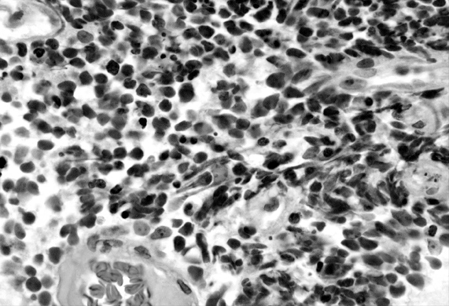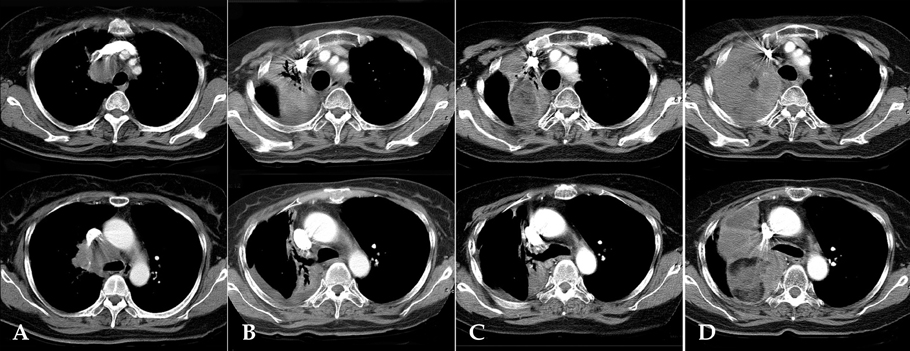Yonsei Med J.
2006 Aug;47(4):571-574. 10.3349/ymj.2006.47.4.571.
Lung Metastasis from an Immature Teratoma of the Nasal Cavity Masquerading as Small Cell Carcinoma of the Lung
- Affiliations
-
- 1Department of Radiation Oncology, Samsung Medical Center, Sungkyunkwan University School of Medicine, Seoul, Korea. ycahn@smc.samsung.co.kr
- 2Department of Medicine, Samsung Medical Center, Sungkyunkwan University School of Medicine, Seoul, Korea.
- 3Department of Pathology, Samsung Medical Center, Sungkyunkwan University School of Medicine, Seoul, Korea.
- 4Department of Radiology, Samsung Medical Center, Sungkyunkwan University School of Medicine, Seoul, Korea.
- KMID: 1779509
- DOI: http://doi.org/10.3349/ymj.2006.47.4.571
Abstract
- We report a case of small cell lung cancer that turned out to be a metastatic teratoma from the nasal cavity rather than a new primary cancer. A 54-year-old woman was diagnosed with an immature teratoma of the nasal cavity with a predominant neuroblastomatous component. Small cell lung cancer was detected by bronchoscopic biopsy 21 months later, and it was treated with concurrent radiochemotherapy as if it had been a new primary cancer. Since a recurrent tumor containing fat- like density grew slowly on the serial chest CT scans after achieving complete response, we reached the conclusion that the small undifferentiated cells could be metastatic neuroblastomatous components from the immature teratoma of the nasal cavity.
Keyword
MeSH Terms
Figure
Cited by 1 articles
-
Congenital Cavernous Sinus Cystic Teratoma
Kyu-Won Shim, Dong-Seok Kim, Joong-Uhn Choi, Se-Hoon Kim
Yonsei Med J. 2007;48(4):704-710. doi: 10.3349/ymj.2007.48.4.704.
Reference
-
1. Heffner DK, Hyams VJ. Teratocarcinosarcoma (malignant teratoma?) of the nasal cavity and paranasal sinuses A clinicopathologic study of 20 cases. Cancer. 1984. 53:2140–2154.2. Lim SC, Choi SJ, Suh CH. A case of small cell carcinoma arising in a mature cystic teratoma of the ovary. Pathol Int. 1998. 48:834–839.3. Sekine I, Sasaki Y, Hasebe T, Mukai K, Kinoshita T, Amano A, et al. Recurrence of a germ cell tumor 12 years after initial treatment: a case report. Jpn J Clin Oncol. 1998. 28:50–53.4. Endo H, Hirose T, Kuwamura KI, Sano T. Case report: Sinonasal teratocarcinosarcoma. Pathol Int. 2001. 51:107–112.5. Ohtsuka M, Satoh H, Inoue M, Yazawa T, Yamashita YT, Sekizawa K, et al. Disseminated metastasis of neuroblastomatous component in immature mediastinal teratoma: a case report. Anticancer Res. 2000. 20:527–530.6. Motzer RJ, Amsterdam A, Prieto V, Sheinfeld J, Murty VV, Mazumdar M, et al. Teratoma with malignant transformation: diverse malignant histologies arising in men with germ cell tumors. J Urol. 1998. 159:133–138.
- Full Text Links
- Actions
-
Cited
- CITED
-
- Close
- Share
- Similar articles
-
- Immature Teratoma of the Nasal Cavity
- Cutaneous Metastasis of Small Cell Lung Cancer Masquerading as Lipomatosis
- A Case of Small Cell Carcinoma of the Maxillary Sinus Coexisting with Fungus Ball
- Two Cases of Non-Small Cell Lung Cancer Masquerading as Metastatic Papillary Thyroid Cancer
- A Case of Paraneoplastic Limbic Encephalitis Associated with Immature Ovarian Teratoma




